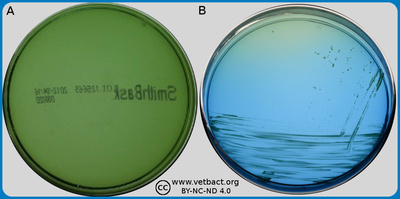Smith-Baskerville mediumThe figure shows agar plates with Smith-Baskervill medium, where bacteria have not been cultivated on plate A. Bordetella bronchiseptica has been cultivated on plates B. Note the colour change from green to blue in the plate whith Bordetella bronchiseptica, which is due to the fact that this bacterium is aerobic and does not ferment carbohydrates. Thus, the medium will turn alkaline during growth. On the upper part of the plate, there is not a sufficient amount of bacterial colonies for colour change of the medium. - Click on the image to enlarge it. Image: Karl-Erik Johansson (BVF, SLU) and Lise-Lotte Fernström (BVF, SLU) ApplicationsSmith-Baskerville (S-B) medium is a selective medium for cultivation of Bordetella bronchiseptica. The medium contains:
The final pH of the medium should be 6.8 at which bromothymol blue is green. The medium turns blue at alkaline pH. Other comments:
Updated: 2018-05-09. |

